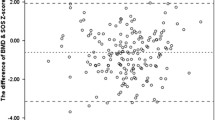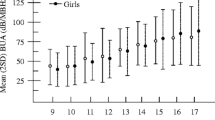Abstract
Summary
This study presents quantitative ultrasonography (QUS) bone quality data for an underrepresented, south Asian pediatric population from Nepal. Data were collected as part of a longitudinal study of growth and development. This study offers normative data and documents the effect of stunting, wasting, and underweight on the bone properties measured by QUS.
Introduction
The purpose of this study was to (1) examine the bone quality of a rural, non-Western pediatric population using QUS, (2) explore variation in the trajectory of bone quality development between males and females, and (3) examine the impact of growth disruption(s) on bone quality.
Methods
A cross-sectional study of 860 children and adolescents aged 5–18 years from the Jirel ethnic group in eastern Nepal was performed. The Sunlight Omnisense 7000P was used to assess bone quality of the distal 1/3 radius and midshaft tibia. WHO reference standards were used to assess growth disruptions of height, weight, and BMI.
Results
QUS bone quality data for an underrepresented, non-Western pediatric population are presented for the radius and tibia. A sizable portion of the study participants were classified as stunted, wasted, and/or underweight. Despite this prevalence of growth disruption in the study sample, bone quality data conform to other documented populations with less growth disruption. Thus, this study offers normative data and documents the minimal effect of stunting, wasting, and underweight on the bone properties measured by QUS.
Conclusions
Non-Western pediatric populations are significantly underserved with regard to simple, non-invasive screening tools that may help identify developmental disorders and assess bone health. The children and adolescents examined here represent normal growth and development for an underrepresented south Asian population. While this work demonstrates that stunting, wasting, or underweight status at time of QUS assessment is not associated with poor bone quality, we do suggest that further study is needed to examine possible cumulative effects of persistent disruptions that may lead to compromised bone quality in later adolescence.



Similar content being viewed by others
References
Baroncelli GI (2008) Quantitative ultrasound methods to assess bone mineral status in children: technical characteristics, performance, and clinical application. Pediatr Res 63:220–228
Wren TAL, Kalkwarf HJ, Zemel BS, Lappe JM, Oberfield S, Shepard JA, Winer KK, Gilsanz V (2015) Longitudinal tracking of dual-energy x-ray absorptiometry bone measures over 6 years in children and adolescents: persistence of low bone mass to maturity. J Pediatr. doi:10.1016/j.jpeds.2013.12.040
Van Rijn RR, van der Sluis IM, Link TM, Grampp S, Guglielmi G, Imhof H, Gluer C, Adams JE, Van Kuijk C (2003) Bone densitometry in children: a critical appraisal. Eur Radiol 13:700–710
Falcini F, Bindi G, Ermini M, Galluzzi F, Poggi G, Rossi S, Masi L, Cimaz R, Brandi ML (2000) Comparison of quantitative calcaneal ultrasound and dual energy X-ray absorptiometry in the evaluation of osteoporotic risk in children with chronic rheumatic diseases. Calcif Tiss Int 67:19–23
Gilsanz V (1998) Bone density in children: a review of the available techniques and indications. Eur J Rad 26:177–182
Gonnelli S, Montagnani A, Gennari L, Martini S, Merlotti D, Cepollaro C, Perrone S, Buonocore G, Nuti R (2004) Feasibility of quantitative ultrasound measurements on the humerus of newborn infants for the assessment of the skeletal status. Osteoporos Int 15:541–546
Zuckerman-Levin N, Yaniv I, Schwartz T, Guttmann H, Hochberg Z (2007) Normal DXA bone mineral density but frail cortical bone in Turner’s Syndrome. Clin Endocrinol 67:60–64
Picard E, Wilkin MK, Mimouni FB, Joseph L, Goldberg S (2013) Ultrasound velocity through the tibia is not affected by prolonged inhaled steroid therapy in children. Acta Paediatr 102:510–513
Mora S, Giacomet V, Vignano A, Cafarelli L, Stucchi S, Pivetti V, Manfredini V, Puzzovio M, Zuccotti G (2012) Exposure to antiretroviral agents during pregnancy does not alter bone status in infants. Bone 50:255–258
Mainz JG, Kaiser WA, Beck JF, Mentzel H-J (2009) Substantially reduced calcaneal bone ultrasound parameters in severe untreated asthma. Respiration 78:230–233
Kutliek S, Bayer M (2010) Quantitative ultrasonometry of the calcaneus in children with osteogenesis imperfecta. J Paediatr Child H 46:592–594
Sundberg M, Gardsell P, Johnell O, Ornstein E, Sernbo I (1998) Comparison of quantitative ultrasound measurements in calcaneus with DXA and SXA at other skeletal sites: a population-based study in 280 children aged 11–16 years. Osteoporos Int 8:410–417
Xu Y, Guo B, Gong J, Xu H, Bai Z (2013) The correlation between calcaneal stiffness index calculated by QUS and total body BMD assessed by DXA in Chinese children and adolescents. J Bone Miner Metab 32:159–166
van den Busche K, Michels N, Garcia-Marco L, Hermann D, Eiben G, de Henauw S, Sioen I (2012) Influence of birth weight on calcaneal bone stiffness in Belgian preadolescent children. Calcif Tiss Int 91:267–275
Wang MC, Moore EC, Crawford PB, Hudes M, Sabry ZI, Marcus R, Bachrach LK (1999) Influence of pre-adolescent diet on the quantitative ultrasound measurements of the calcaneus in young adult women. Osteoporos Int 9:532–535
Hirota T, Kusu T, Hirota K (2005) Improvement of nutrition stimulates bone mineral gain in Japanese school children and adolescents. Osteoporos Int 16:1057–1064
McDevitt H, Tomlinson C, White MP, Ahmed SF (2007) Changes in quantitative ultrasound in infants born at less than 32 weeks’ gestation over the first 2 years of life: influence of clinical and biochemical changes. Calcif Tissue Int 81:263–269
Tomlinson C, McDevitt H, Ahmed SF, White MP (2006) Longitudinal changes in bone health as assessed by the speed of sound in very low birth weight preterm infants. J Pediatr 148:450–455
Falk B, Bronstein Z, Zigel L, Constantini NW, Eliakim A (2003) Quantitative ultrasound of the tibia and radius in prepubertal and early-pubertal female athletes. Arch Pediatr Adolesc Med 157:139–143
Zadik Z, Sinai T, Borondukov E, Zung A, Yaniv I, Reifen R (2005) Longitudinal monitoring of bone accretion measured by quantitative multi-site ultrasound (QUS) of bones in patients with delayed puberty (a pilot study). Osteoporos Int 16:1036–1041
Liao XP, Zhang WL, He JM, Sun JH, Huang P (2005) Examination of infant bone status with quantitative ultrasound at birth. Zhonghua Er Ke Za Zhi 43:128–132
Liao XP, Zhang WL, He JM, Sun JH, Huang P (2005) Bone measurements of infants in the first 3 months of life by quantitative ultrasound: the influence of gestational age, season, and postnatal age. Pediatr Radiol 35:847–853
Teitelbaum JE, Ashmeade TL, Yaniv I, Osuntokum BO, Hudome S, Fanaroff A (2006) Quantitative ultrasound in the evaluation of bone status in premature and full-term infants. J Clin Densitom 9:358–362
van den Bergh JPW, Noordam C, Ozyilmaz A, Hermus ARMM, Smals AGH, Otten B (2000) Calcaneal ultrasound imaging in healthy children and adolescents: relation of the ultrasound parameters BUA and SOS to age, body weight, height, foot dimensions and pubertal stage. Osteoporos Int 11:967–976
Alwis G, Rosengre B, Nilsson JA, Stenevi-Lundgren S, Sundberg M, Sernbo I, Karlsson MK (2010) Normative calcaneal quantitative ultrasound data as an estimation of skeletal development in Swedish children and adolescents. Calcif Tissue Int 87:493–506
Williams-Blangero S (1990) Population structure of the Jirels: patterns of mate choice. Am J Phys Anthropol 82:61–72
Williams-Blangero S, Blangero J, Robinson E, Adhikhari B, Upreti R, Pyrakurel S (1993) Helminthic infections in Jiri, Nepal: analysis of age and ethnic group effects. J Inst Med 15:210–216
Williams-Blangero S, Subedi J, Upadhayay R, Manral D, Rai D, Jha B, Robinson E, Blangero J (1999) Genetic analysis of susceptibility to infection with Ascaris lumbricoides. Amer J Trop Med Hyg 60:921–926
Williams-Blangero S, Towne B, Subedi J, Blangero J (2002) Genetic studies of the Jirels: from population genetics to genetic epidemiology. In: Subedi J (ed) Halfway to the mountain: the Jirels of Eastern Nepal. Tribhuvan U Press, Kathmandu
Williams-Blangero S, Criscione CD, Anderson TJC et al (2012) Host genetics and population structure effects on parasitic disease. Roy Soc Ph Trans B 367:887–894
Williams KD, Blangero J, Cottom CR, Lawrence S, Jha B, Subedi J, Williams-Blangero S, Towne B (2007) Methods for phenotyping brachydactyly type A3 and related anomalies in an endogamous population from eastern Nepal. Am J Hum Biol 19:288
Williams KD, Blangero J, Subedi J, Jha B, Dyer TD, Vande Berg JL, Towne B, Williams-Blangero S (2013) Non-syndromic brachydactyly type D and type E mapped to 7p15 in healthy children and adults from the Jirel Ethnic Group in Eastern Nepal. Am J Hum Biol 25:743–750
Williams KD, Nahhas RW, Cottom CR, Lawrence S, Subedi J, Jha B, Blangero J, Williams-Blangero S, Towne B (2012) Evaluation of qualitative methods for phenotyping brachymesophalangia-V from radiographs of children. Am J Hum Biol 24:68–73
Sunlight Omnisense 70000S/8000S User Guide. U.S.Software version 2.2
Foldes AJ, Rimon A, Keinan DD, Popovter MM (1995) Quantitative ultrasound of the tibia: a novel approach for assessment of bone status. Bone 17:363–367
Lowet G, van der Perre G (1996) Ultrasound velocity measurement in long bones: measurement method and simulation of ultrasound wave propagation. J Biomech 29:1255–1262
de Onis M, Onyango AW, Borghi E, Siyam A, Nishida C, Siekmann J (2007) Development of a WHO growth reference for school-aged children and adolescents. B World Health Organ 85:660–667
Zadik Z, Price D, Diamond G (2003) Pediatric reference curves for the multi-site quantitative ultrasound and its modulators. Osteoporos Int 14:857–862
Christoforidis A, Papadopoulou E, Dimitriadou M, Stilpnopoulou D, Gkoqka C, Katzos G, Athanassiou-Metaxa M (2009) Reference values for quantitative ultrasonography (QUS) of radius and tibia in healthy Greek pediatric population: clinical correlations. J Clin Densitom 12:360–368
Baptista F, Fragoso I, Branco J, Alves de Mateo A, Sardinha LB (2011) Reference data for bone speed of sound in Portuguese girls and boys aged 9–13 years. J Clin Densitom 14(4):484–491
Rivas-Ruiz R, Talavera JO, Huitron G, Tamayo JA, Salmeron J (2015) Bone speed of sound throughout lifetime assessed with quantitative ultrasound in a Mexican population. J Clin Densitom 18(1):68–75
Omar A, Turan S, Bereket A (2006) Reference data for bone speed of sound measurement by quantitative ultrasound in healthy children. Arch Osteoporos 1:37–41
Warden SJ, Roosa SMM, Kersh ME, Hurd AL, Fleisig GS, Pandy MG (2014) Physical activity when young provides lifelong benefits to cortical bone size and strength in men. Proc Natl Acad Sci U S A 111:5337–5342
Acknowledgments
This work was supported by the National Institutes of Health grants: F32 HD053206 (Williams), R01 HD40377 (Towne), R01 AI370919 (Williams-Blangero), R01 AI44406 (Williams-Blangero), R01 AR055632 (Mahaney), and R01 MH59490 (Blangero). This work was also supported by Temple University and by a Wright State University Boonshoft School of Medicine Seed Grant.
We thank Mr. Robin Singh, Mr. Suman Jirel, Ms. Sanjita Jirel, Ms. Samana Jirel, and all current and former staff members of the Jiri Growth Study and the Jiri Helminth Project for their hard work and dedication. In addition, we respectfully acknowledge and thank the members of the Jirel community for their generous participation in this study. We also thank Paige Randazzo for her assistance in the preparation of this manuscript.
Conflicts of interest
None.
Author information
Authors and Affiliations
Corresponding author
Rights and permissions
About this article
Cite this article
Williams, K.D., Blangero, J., Mahaney, M.C. et al. Axial quantitative ultrasound assessment of pediatric bone quality in eastern Nepal. Osteoporos Int 26, 2319–2328 (2015). https://doi.org/10.1007/s00198-015-3115-0
Received:
Accepted:
Published:
Issue Date:
DOI: https://doi.org/10.1007/s00198-015-3115-0




